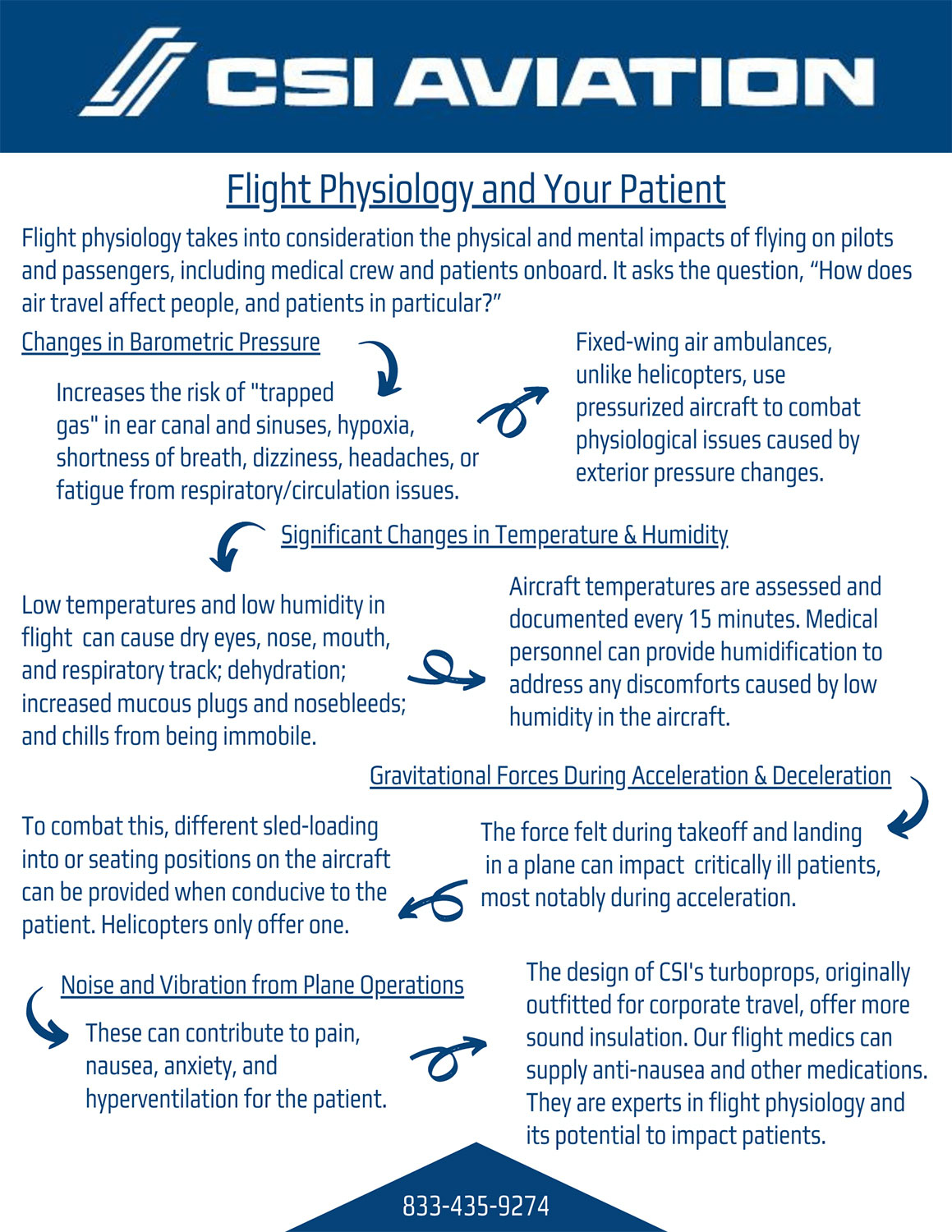Flight physiology takes into consideration the physical and mental impacts of flying on pilots and passengers, including medical crew and patients onboard. It asks the question, “How does air travel affect people?”
When it comes to flying, multiple environmental factors play into our ability to adapt in the air:
- Changes in barometric pressure
- The higher you go in elevation; the less dense air becomes. This can cause gas to expand as air molecules move away from each other, which can create the “trapped gas” effect in the ear canal and sinuses. The “ear popping” sensation may be most noticeable during takeoff.
- Too-sudden changes in air pressure or altitude can lead to hypoxia, especially in patients already at risk of the condition. Hypoxia at high altitudes occurs when the lungs cannot get enough oxygen due to the spaced-out molecules. Nearly all patients requiring a medical flight are already closer to hypoxia because of their condition.
- A sudden drop in air pressure can upset the respiratory and circulation systems in the body, possibly causing dizziness, headaches, shortness of breath, or exhaustion.
Fixed-wing air ambulances use pressurized aircraft to combat all physiological issues caused by exterior pressure and altitude changes. Rotor-wing, or helicopter, air ambulances fly low and without a pressurized interior.
- Significant variation in temperature and humidity
- Changes in temperature and humidity can cause patients to experience dry eyes, nose, mouth, and respiratory track, as well as the potential for dehydration and increased mucous plugs.
- The potential for nosebleeds increases
- Due to their condition, some patients might need extra layering to ensure they stay warm.
Our aircraft temperatures are assessed and documented every 15 minutes, like vital signs, and can be adjusted as needed. Cabin humidity typically sits around 20%. While filtration systems thoroughly sanitize the interior air, the extra dryness can contribute to discomforts that our medical personnel are equipped to combat. For example, they can provide humidification to specifically prevent nosebleeds and have hospital-grade blankets for patients susceptible to cold.
- Gravitational forces during acceleration and deceleration
- The force felt during takeoff and landing in a plane can impact critically ill patients, most notably during acceleration.
The effect of such movement should be considered when determining whether a patient is fit for transport. Acceleration forces have the potential to contribute to hypertension, dysrhythmias, compartmental fluid shifts, tachycardia, increased intracranial pressure, decreased cerebral oxygen pressure, and decreased venous return/cardiac output. Feet-first sled-loading entry can be accommodated needed, as well as different seating positions in the plane. Helicopters can only load a patient one way on a stretcher. Our aircraft cabins offer seating arrangements conducive to a patient’s needs.
- Noise and Vibration
- Though not often considered, noise and vibration from plane operations can contribute to pain, nausea, and anxiety for the patient. This should be noted and treated as needed.
To combat potential negative effects of these changes, pressurized cabins and temperature control are a necessity. The design of CSI’s turboprops, originally outfitted for corporate travel, offer more sound insulation than other types of aircraft. In addition, our flight medics are experts in flight physiology and its effect on patients whose condition puts them at an increased risk of flight-related complications. They can supply anti-nausea and other medications as needed.
To prepare a patient for transport, CSI Aviation has created a standardized set of procedures to enable our medical team to provide the highest level of care. Our highly trained flight paramedics and nurses are extensively experienced in analyzing a patient’s condition in relation to flight physiology. We will be the first to tell you if a patient’s condition disqualifies them from in-flight transport. The health and safety of our patients during and after transport is of greatest importance.




